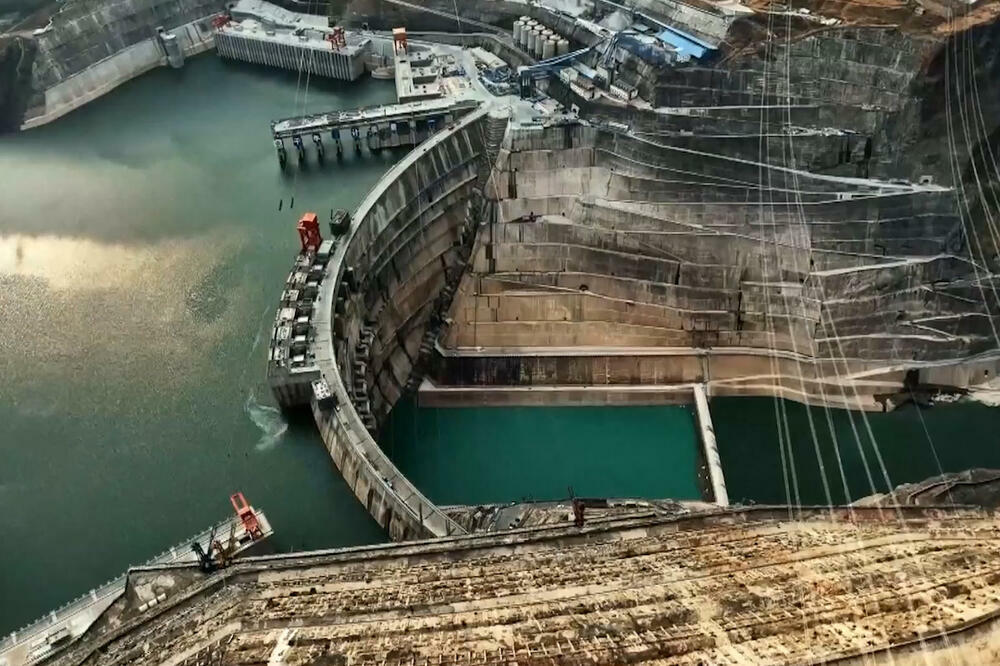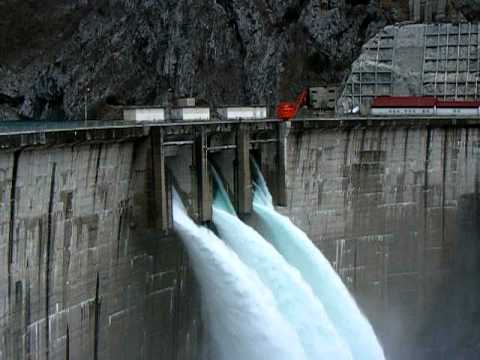Table of Contents
- Introduction
- Brief history and important inventions
- Modern Hydroelectric power plants
- Basic parts of a hydroelectric power plant
- Conclusion
Introduction
Welcome guys. In today’s topic we are going to talk about one of the most common sources of power in the 21. century. Hydro energy is one of the oldest and largest sources of renewable energy, which uses the natural flow of moving water to generate electricity. The potential and traces of hydro energy goes back even to the times of Ancient Egypt, Persia and China, where hydro energy was used turn the mill wheel for the operation of the grain mill, and all the other machines/constructions like this.
How the time passed, and the technology evolved, by the end of 19. century and start of the 20.eth century, hydro energy was used for the mechanical starting and work of machines using belt drive. The invention of the electric generator and other constructions of turbines, made the use of hydro energy for production of electrical energy.
Brief history and important inventions
James Francis (1815-1892) in 1848. invented the Francis turbine. The Francis turbine is a type of water turbine. It is an inward-flow reaction turbine that combines radial and axial flow concepts. Francis turbines are the most common water turbine in use today, and can achieve over 95% efficiency.
Lester Allen Pelton (1829-1908) in 1970 invented the Pelton turbine. A Pelton wheel uses the impulse of the water to generate energy, not its weight. Pelton wheels are used in power plants where there’s a big difference in height, but where there is relatively little water. An example might be a dam or barrage in the mountains.
Viktor Kaplan (1876-1912) in 1912. invented the Kaplan turbine. The Kaplan turbine is a propeller-type water turbine which has adjustable blades. It combined automatically adjusted propeller blades with automatically adjusted wicket gates to achieve efficiency over a wide range of flow and water level.
Werner von Siemens (1816-1892), Charles Whatstone (1802-1875), Samuel Alfred Varley (1832-1921), they invented at about the same time from 1866-1867 the electric generator. And in electricity generation, a generator is a device that converts motive power (mechanical energy) into electric power for use in an external circuit.
The first house on planet that used electricity (electrical energy), that power was produced in a hydroelectric power plant, was the house of William Armstrong (Rothbury, England). That commercial test was introduced in 1878.
The first commercial hydroelectric power plant was constructed on the Niagara Waterfalls in 1897. The following years, hydroelectric plants and their capacity rose up to an exponential level. For example the biggest hydroelectric power plant was put into operation in 1936., the “Hover” power plant stationed in the U.S. had the power/strength of 1.345 MW.
The Grand Coulee power plant had the power of 6.809 MW, also in the U.S., and it was released in 1942. In China, the Three Gorges power plant dam had the power of 22.500 MW.
Modern Hydroelectric power plants
Today, in some countries over 85% of electricity is produced from hydropower, for example like Norway, Paraguay and Brazil. Although there is a significant difference in the installed capacity of the two largest hydropower plants in the world. For example, the Three Gorges dam on the Yangtze river has the power of 22,500 MW and Itaipu on the Parana River which has 14,000 MW, that’s due to the variable flow of the Yangtze river, that leads to the fact that the annual production of both of them is approximately the same. Besides being one of the largest sources of electric energy, the largest hydroelectric power plants are among the largest man-made buildings to. Today, hydropower is an important source of electricity in the world. Electric energy produced from hydroelectric power plants made around 16.7% of the total electricity produced in the world. And around 76% of electricity from renewable sources.
list of the biggest hydroelectric power plants:
1. Three gorges Dam

The Three Gorges Dam is a hydroelectric gravity dam that spans the Yangtze River by the town of Sandouping, in Yiling District, Yichang, Hubei province, central China, downstream of the Three Gorges. The Three Gorges Dam has been the world’s largest power station in terms of installed capacity (22,500 MW) since 2012 (10% of China’s electricity). The dam body was completed in 2006. And the power plant of the dam project was completed and fully functional as of July 4, 2012. Coupling the dam’s 32 main turbines with two smaller generators (50 MW each) to power the plant itself, the total electric generating capacity of the dam is 22,500 MW.
2. Itaipu Dam

The Itaipu Dam is a hydroelectric dam on the Paraná River located on the border between Brazil and Paraguay. The construction of the dam was first contested by Argentina, but the negotiations and resolution of the dispute ended up setting the basis for Argentine–Brazilian integration later on. The installed generation capacity of the plant is 14 GW, with 20 generating units providing 700 MW each with a hydraulic design head of 118 metres. In 2016, the plant employed 3038 workers. The total electric generating capacity of the dam is 14,000 MW.
3. Xiluodu Dam

The Xiluodu Dam is an arch dam on the Jinsha River, i.e. the upper course of the Yangtze in China. It is located near the town of Xiluodu in Yongshan County of Yunnan Province. The primary purpose of the dam is hydroelectric power generation and its power station has an installed capacity of 13,860 MW. Additionally, the dam provides for flood control, silt control and its regulated water releases are intended to improve navigation downstream. Construction on the dam and power station began in 2005 and the first generator was commissioned in 2013, the last in 2014.
Some important mentions to are the following: Guri-Venezuela power plant, Tucurui-Brazil power plant, The Grand Coulee-United Stated power plant and many more…
Basic parts of a hydroelectric power plant
Reservoir
Dam
Trace rack
Forebay
Surge tank
Penstock
Spillway
Turbine
Powerhouse
Reservoir
It is the basic requirement of a hydroelectric plant. Its purpose is to store water during excess flow periods (i.e., rainy season) and supply the same during lean flow periods (i.e., dry season) and thus it helps in supplying water to the turbines according to the load on the power plant.
Dam
The function of dam is not only to raise the water surface of the stream to create an artificial head but also to provide the pondage, storage or the facility of diversion into conduits. A dam is the most expensive and important part of a hydro-project. Dams are built of concrete or stone masonry, earth or rock fill.
Trace rack
These are built up from long, flat bars set vertically or nearly so and spaced in accordance with the minimum width of water passage through the turbine. The clear space between the bars varies from 25 mm or 40 mm to 150 or 200 mm on very large installations. These are to prevent the ingress of floating and other material to the turbine.
Forebay
The forebay serves as a regulating reservoir storing water temporarily during light load period and providing the same for initial increase on account of increasing load during which water in the canal is being accelerated. In short, a forebay may be considered as an enlarged body of water just above the intake to store water temporarily to meet the hourly load fluctuations.
Surge tank
A surge tanl is a cylindrical tank which is open at the top to control the pressure in the pentstock. It is connected to the penstock and as close as possible to the power house. So, whenever the power house rejected the water load coming from penstock the water level in the surge tank rises and control the pressure in penstock.
Penstock
The penstock is a sluice or gate or intake structure that controls water flow, or an enclosed pipe that delivers water to hydro turbines and sewerage systems. The term is inherited from the earlier technology of mill ponds and watermills. hey can be a combination of many components such as anchor block, drain valve, air bleed valve, and support piers depending on the application. Steel or Reinforced concrete is used for making penstocks.
Spillway
The Spillway is an safety valve. Its task is to discharge the overflow of the water down to the down-stream side when the reservoir is full. They are generally constructed of concrete, and provided with water discharge opening shut off by metal control gates.
Turbine
n hydroelectric power plants, water turbines are used as prime movers and their function is to convert the kinetic energy of water into mechanical energy which is utilized to drive the alternators generating electrical energy.
If reaction turbines are used, then draft tube is a necessary component which connects turbine outlet to the tailrace. The draft tube contains gradually increasing diameter so that the water discharged into the tailrace with safe velocity.
Power house
It is the building that protects the hydraulic and electrical equipment. Generally, the whole equipment is supported by the foundation laid for the power house.

Conclusion
The price of electricity from hydropower plants is practically independent from the price and availability of fossil fuels such as coal, oil, and natural gas. Hydropower plants also have a long lifespan, from 50 to 100 years. The cost of hired labor is significantly lower compared to thermal power plants to.
In the process of electricity production in hydroelectric power plants there is no emission of gases, as is the case with thermal power plants, where we have the combustion of mostly fossil fuels. Hydroelectric dams often provide protection from torrents and floods, mitigate droughts, and on the formed artificial lakes, boat traffic, aquaculture (fish, crabs, shellfish, aquatic plants, etc.), tourism and other recreational activities are possible. There is more to say when it comes to hydropower plants, from their advantages and disadvantages, their types and lot more. In today’s article we just scratched the surface of these great engineering constructions, and we will soon have more articles explaining the work of them and every aspect of them to.
- Market Capitalization (explained) - November 8, 2022
- Best affordable graphics cards in 2022(guide) - November 8, 2022
- Hydro energy (explained) - November 8, 2022
